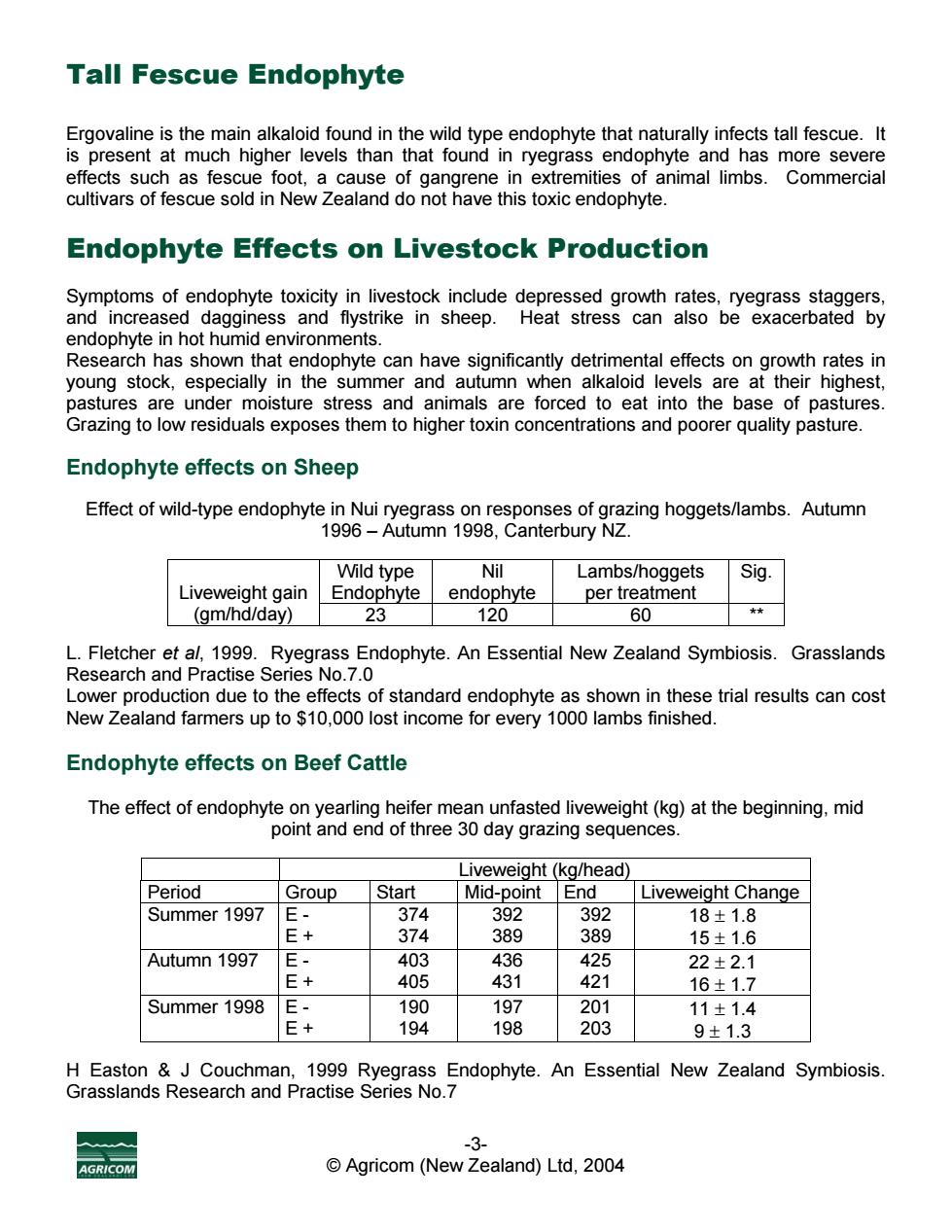正在加载图片...

Tall Fescue Endophyte Ergovaline is the main alkaloid found in the wild type endophyte that naturally infects tall fescue.It is present at much higher levels than that found in ryegrass endophyte and has more severe effects such as fescue foot,a cause of gangrene in extremities of animal limbs. Commercial cultivars of fescue sold in New Zealand do not have this toxic endophyte. Endophyte Effects on Livestock Production Symptoms of endophyte toxicity in livestock include depressed growth rates,ryegrass staggers and increased dag ess and flystrike in sheep.Heat stress can also be exacerbated by endophvte in hot hum ch hassh thatendohyte can have sinificanty detrimental effects on grow ratesin especial in the ummer and autu nn wh n alkaloid levels are their hiahest res a oisture are forced to the f pastu res Endophyte effects on Sheep Effect of wild-type endophyte Auturss oresponses or gvazing noggets/ambs.Autumn Wild type Nil Sig. Livew eight gain End yte Laeee per tre (gm/hd/day) 23 nyte 120 60 Research and Prac cts of standard endophyte as shown in th se trial results can cos ealand farmers up to $10,000 lost income for every 1000 lambs finishe Endophyte effects on Beef Cattle The effect of endophyte on yearling heifer mean unfasted liveweight(kg)at the beginning,mid point and end of three 30 day grazing sequences Liveweight(kg/head) Period Group I Start Mid-point I End Liveweight Change Summer 1997 374 207 202 E+ 374 389 389 15±1.6 Autumn 1997 E 40: 436 425 22±2.1 + 405 431 421 16±1.7 Summer 1998 E- 190 197 01 11+14 F+ 194 198 203 9±1.3 ries No.7 3- Agricom(New Zealand)Ltd,2004 Tall Fescue Endophyte Ergovaline is the main alkaloid found in the wild type endophyte that naturally infects tall fescue. It is present at much higher levels than that found in ryegrass endophyte and has more severe effects such as fescue foot, a cause of gangrene in extremities of animal limbs. Commercial cultivars of fescue sold in New Zealand do not have this toxic endophyte. Endophyte Effects on Livestock Production Symptoms of endophyte toxicity in livestock include depressed growth rates, ryegrass staggers, and increased dagginess and flystrike in sheep. Heat stress can also be exacerbated by endophyte in hot humid environments. Research has shown that endophyte can have significantly detrimental effects on growth rates in young stock, especially in the summer and autumn when alkaloid levels are at their highest, pastures are under moisture stress and animals are forced to eat into the base of pastures. Grazing to low residuals exposes them to higher toxin concentrations and poorer quality pasture. Endophyte effects on Sheep Effect of wild-type endophyte in Nui ryegrass on responses of grazing hoggets/lambs. Autumn 1996 – Autumn 1998, Canterbury NZ. Wild type Endophyte Nil endophyte Lambs/hoggets per treatment Sig. Liveweight gain (gm/hd/day) 23 120 60 ** L. Fletcher et al, 1999. Ryegrass Endophyte. An Essential New Zealand Symbiosis. Grasslands Research and Practise Series No.7.0 Lower production due to the effects of standard endophyte as shown in these trial results can cost New Zealand farmers up to $10,000 lost income for every 1000 lambs finished. Endophyte effects on Beef Cattle The effect of endophyte on yearling heifer mean unfasted liveweight (kg) at the beginning, mid point and end of three 30 day grazing sequences. Liveweight (kg/head) Period Group Start Mid-point End Liveweight Change Summer 1997 E - E + 374 374 392 389 392 389 18 ± 1.8 15 ± 1.6 Autumn 1997 E - E + 403 405 436 431 425 421 22 ± 2.1 16 ± 1.7 Summer 1998 E - E + 190 194 197 198 201 203 11 ± 1.4 9 ± 1.3 H Easton & J Couchman, 1999 Ryegrass Endophyte. An Essential New Zealand Symbiosis. Grasslands Research and Practise Series No.7 -3- © Agricom (New Zealand) Ltd, 2004